2019 BMW Z4 sDrive30i vs. 2019 Porsche 718 Boxster: Which Makes for a Better Summer?
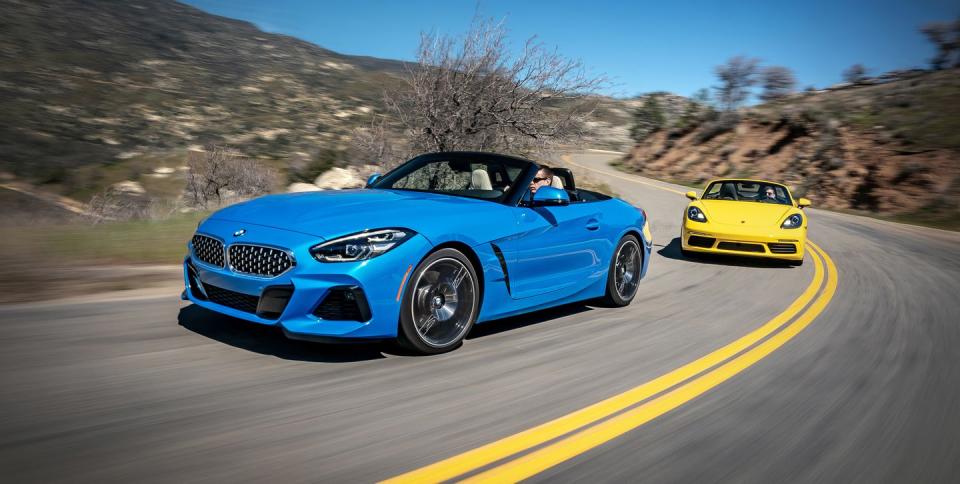
In Greater Los Angeles, the BMW Z4 and the Porsche 718 Boxster attract as much attention as a Toyota Prius. Drive three hours north to Lake Isabella, though, and you might as well be rolling a gold-plated M1 Abrams tank through the town's ragged streets. People stare. They roll down their windows and want to know what they're seeing. They holler from the liquor-store parking lot, or pull up shirtless in a car with mismatched all-season tires, tell you their life story, and challenge you to a $1000 race.
Lake Isabella, with the nearby ghost-town remnants of a gold-mining boom-and-bust, is no wealthy hamlet. The locals are, however, rich in great driving roads. Whether you head north, south, east, or west, leaving town means traveling on scribbles that look like a late-period Sol LeWitt drawing. As a California summer blossoms, these roads are the perfect place for a pair of ragtop sports cars.
After nearly a decade spent with a folding aluminum roof, the BMW Z4 returns to the Z car's roots as a softtop convertible and a coupe. Granted, the coupe now answers to the name Toyota Supra, but it's built on the same bones and powered by BMW engines, making it a Z4 in everything but name and looks. Until the 382-hp Z4 M40i arrives later this year, BMW's sole offering is this sDrive30i, which drives its rear wheels with a 255-hp turbocharged 2.0-liter inline-four lashed to an eight-speed automatic.
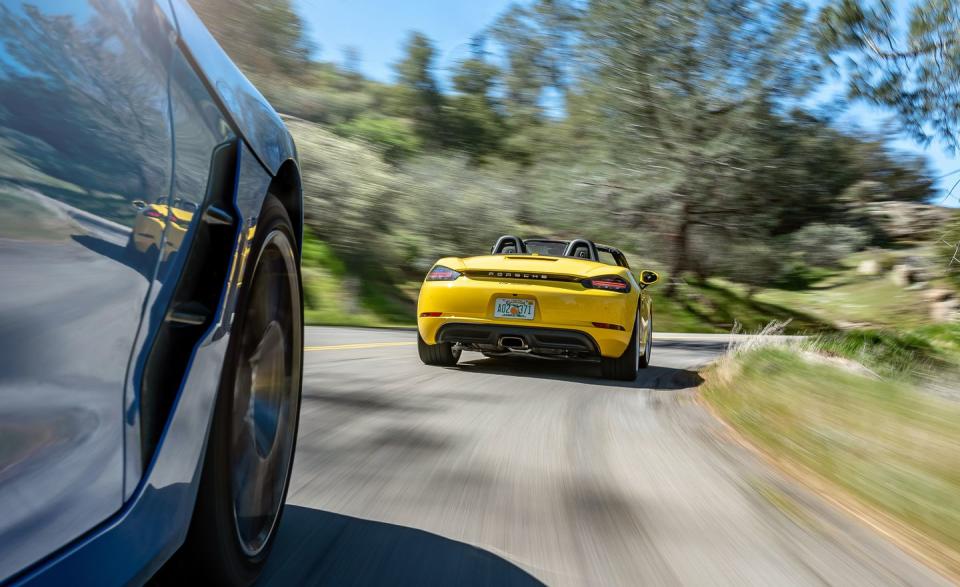
Pricing starts at $50,695 and swells quickly. Our test car came equipped with the Executive package ($2500), the Premium package ($1600), and the deceptively named M Sport package ($2950), which has nothing to do with M or even, broadly speaking, automotive athleticism. Instead, the M Sport kit adds passive entry, satellite radio, parking sensors, blind-spot monitoring, lane-departure warning, and a dose of visual flair. The real M-inspired hardware can be found in our car's $700 adaptive dampers and the $2450 Track Handling package that adds larger brake discs, performance pads, and an electronically controlled limited-slip differential. Adaptive cruise control, 19-inch wheels, remote start, and the Misano Blue Metallic paint raise the bill to $63,545.

The BMW comes off as a veritable bargain next to its competition. While it's roughly $4500 more expensive, the Racing Yellow Boxster on these pages could easily be the most basic 718 you will ever lay eyes on. With a mere $7820 in add-ons, this Porsche features single-zone manual climate control, seats with less adjustability than a Volkswagen Golf's, and a six-speaker stereo that has the dynamic range of a foghorn. Notable upgrades include navigation ($2320), PASM adaptive dampers ($1790), heated seats ($530), and Apple CarPlay ($360). With an out-the-door price of $68,070, the Boxster cedes eight points to the Z4 in the scorecard's price and features categories alone. That's not enough to make it an underdog, though. The 718-in 350-hp Cayman S guise-already dispatched the ballistic 400-hp Audi TT RS during a March 2018 comparison test, and the junior Porsche sports car claims 20 10Best nods dating to the first-generation car. Three hundred horses stampede from the Boxster's mid-mounted turbocharged 2.0-liter flat-four and are corralled via a six-speed manual. The PDK seven-speed dual-clutch automatic would have given us pedal parity with the Z4, but we weren't about to penalize Porsche for BMW's folly.
The shirtless kid, who called himself Hannibal, didn't get his race. We did, though. After two days exploring Lake Isabella's treasures, we have a winner.
2nd Place:
BMW Z4 sDrive30i
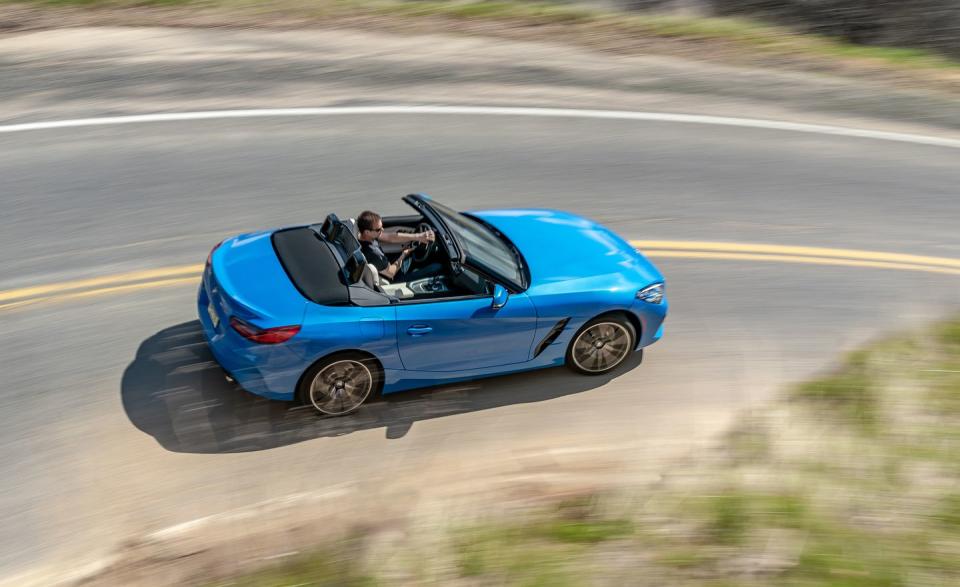
Highs: Sticks and stops like a Porsche, equal parts luxury and sport.
Lows: We recommend a low-fat diet and a power-building fitness regimen.
Verdict: Standby for the forthcoming 382-hp Z4 M40i.
Tellingly, BMW doesn't make a weight-savings claim for the reborn Z4 with the ragtop. A body that is longer, wider, and taller than its predecessor's precludes any diminution of mass, our test car weighing in at a substantial 3407 pounds. Down 45 horses and up 348 pounds on the Porsche, the Z4 can't hang with the Boxster even with the quick-shifting advantage of ZF's superb eight-speed automatic transmission. The Z4 leaves the line without so much as a squeak from the rear end, a product of its piggish heft and sticky tires rather than the launch-control logic. Short-shifting at 5500 rpm through the first three gears, the Z4 notches 60 mph in 5.1 seconds and clears the quarter-mile in 13.8 seconds at 102 mph. Whether that seems quick or not depends on your experience within the four-wheeled world. We'll simply point out that a Honda Accord with the turbo 2.0-liter and 10-speed automatic practically runs in lockstep.
Impressively, the BMW shrugs off its extra poundage to snap at the Porsche's tail around the skidpad, through the slalom, and during brake stops. Credit the Z4's additional 4.1 inches of track width up front and 2.9 inches in the rear compared with the Boxster, along with its Michelin Pilot Super Sport tires, which are wider than the Porsche's Pirellis. On the road, though, the front-engined BMW demands more effort, more chutzpah, and more armpit sweat to do what the mid-engined Porsche does with Joe Camel cool. The body rolls and bobs with larger motions, and the steering does little to inspire confidence. The BMW's pudgy M Sport steering wheel ties to a variable-ratio rack that's too quick, imprecise in S-curve transitions, and wanting for more feedback. Nothing turns you into a steering snob quite like driving a Porsche.
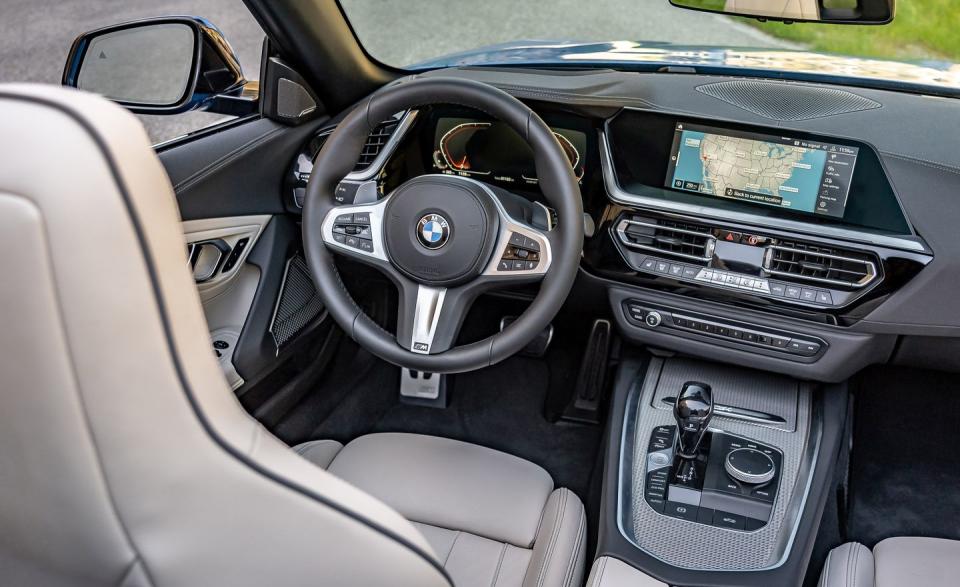
We briefly wondered if the designers originally rendered the Z4 in papier-mâché rather than clay, as the car's swollen kidneys and bulging headlights look like heavy-handed caricatures of familiar BMW shapes. In profile, the Z4's rising character line has strong undertones of Mercedes-Benz SLK. The work inside is more successful, with the stitched dash, patterned trim, and sculptural seats standing in stark contrast to the Boxster's Spartanism. Posh, plush, and packed with tech, our BMW includes a Wi-Fi hotspot and corner-illuminating headlights. The familiar iDrive knob, increasingly overburdened by the infotainment system's growing complexity, benefits from redundant touchscreen control. Inflatable bolsters, four-way lumbar, and adjustable seat pans tailor the chairs to any body shape, providing limitless highway comfort. And the Z4 shames the Boxster with small-item storage options such as the cellphone tray ahead of the shifter, a trunk pass-through that doubles as a second glovebox, and a parcel shelf with a cargo net behind the seats that catches water bottles, purses, and jackets. BMW throws in three years of oil changes and filter replacements with the base price but only one year of Apple CarPlay compatibility. After that, you'll pay $80 per annum for the privilege of using the iPhone you own with the car you own. It almost makes Porsche's prices seem sensible.
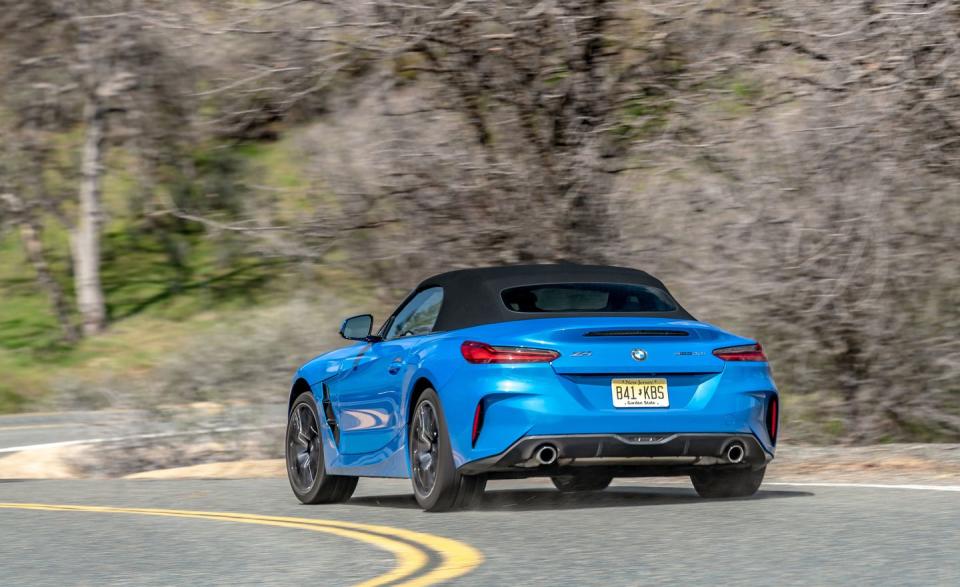
Seven different drive modes are at least four too many. One adapts to your driving style; two are customizable Individual modes that allow you to separately select damper, steering, engine, and transmission settings; and four have been locked in by the engineering team. This creates an exceptional and unnecessary amount of fiddliness but also subtly underscores the Z4's strength. Equal parts grand tourer and sports car, the Z4 capably plays multiple roles. It's comfortable enough to be a daily driver and special enough to reserve for weekend escapes.
For a company that built its reputation on sports sedans, BMW claims few bona fide sports cars in its past. This new Z4 is yet another example that toes the line and challenges you to question your definition of a sports car. It corners and brakes with the proper intensity but also begs for more muscle, less fat, and sharper steering. In isolation, the Z4's breadth strikes us as brilliant. Its biggest problem might be that we didn't drive it in isolation.
1st Place:
Porsche 718 Boxster
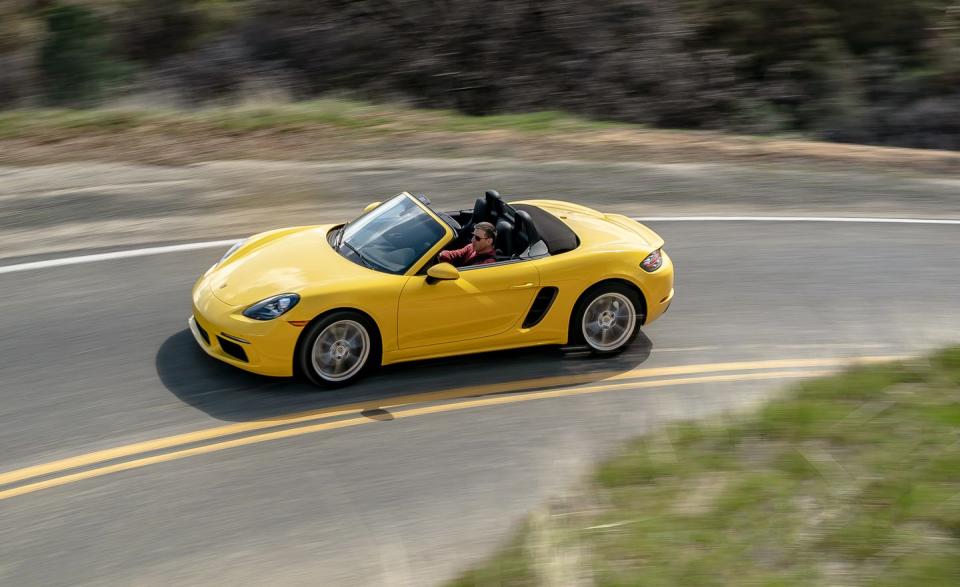
Highs: Feels engaging and at home on any road; that sweet, sweet manual transmission.
Lows: A $68,070 stripper, turbo lag from another era.
Verdict: It could cost more and we'd still be enamored.
The Porsche 718's goodness is so flagrant that you can sense it in even mundane situations. The specialness is palpable in a roundabout, on a cloverleaf interchange, and even during an aggressive lane change. Steer it onto a mountain road such as California State Route 155, however, and the subsequent dopamine tsunami will turn you into a raving, slobbering kook. The Boxster delivers the thrills and rewards of cars priced $200,000 higher. That's not an exaggeration, although the temptation to succumb to hyperbole still runs high a week after driving this thing.
On 155, the six-speed manual's long ratios allow you to drive for miles in second gear, stretching the four-cylinder's fat torque band over a broad spread of speeds and revs. Porsche's flat-four spins faster and with more charisma than the BMW's inline engine, even if it won't sing to you as its predecessor's six-cylinder did. Instead, it carries on a conversation of blats, snorts, and chuckles far more entertaining than the BMW's dull snuffle. We've come to understand that the Boxster's engine still has character, even if that character has a few more rough edges than it should.
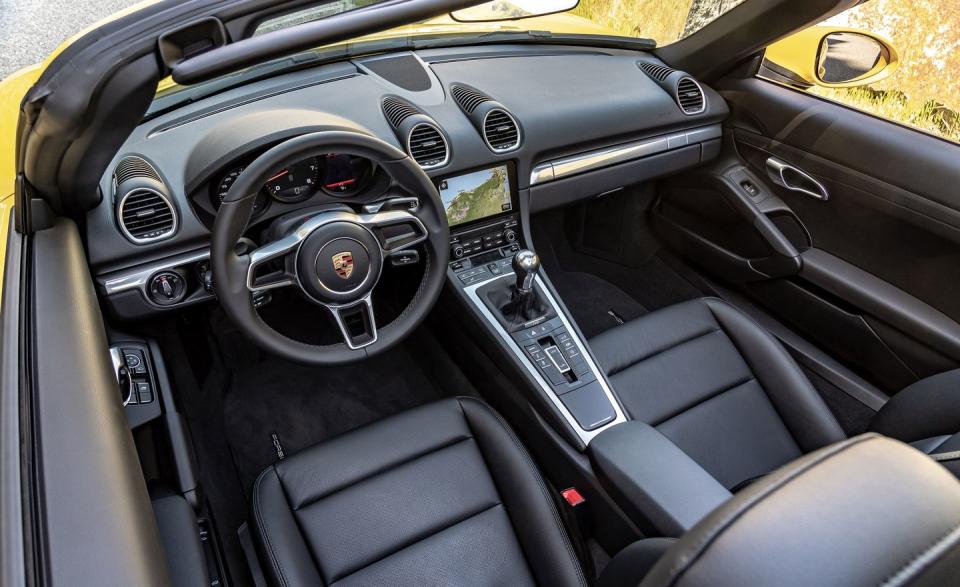
The trade-off for the flat-four's mighty power density (150.9 horsepower per liter) is a breath of lag at the low end as the turbo huffs up to speed. The optional seven-speed dual-clutch automatic mostly masks this old-fashioned behavior with right-now downshifts and just-right clutch actuation. Manual-transmission buyers will learn to do the same by keeping the tachometer simmering in traffic and slipping the clutch off the line.
The flat-four wants to bog at the track, too, where a 4000-rpm launch (a limiter caps revs at 4500 rpm when the vehicle is stationary) will overcome the P Zero PZ4s' grip only with a cruel clutch slip. Do it right and you'll know it by the momentary scrape of spinning rubber and the sudden smearing of the view out the windshield. We saw 60 mph arrive in 4.6 seconds and the quarter-mile pass in 13.0.
The Boxster corners at 1.01 g's. It skates through the slalom with the nimbleness of a sparrow and the grounded stability of a coastal redwood. It stops from 70 mph in a succinct 146 feet, matching the BMW. These performances point to the 718's defining trait, which you can know only once you've driven one: equilibrium. In the Boxster, no single attribute is significantly stronger or weaker than the next. Even when Porsche builds monsters like the record-slaying 700-hp 911 GT2 RS, its cars never sacrifice control for speed. They confidently walk the driver up to the limit, point a finger, and speak plainly: "This is the line. Cross it if you dare, but don't say I didn't warn you." It's that open-book communication and transparent handling that led contributor Scott Oldham to state, "This car is a living thing."
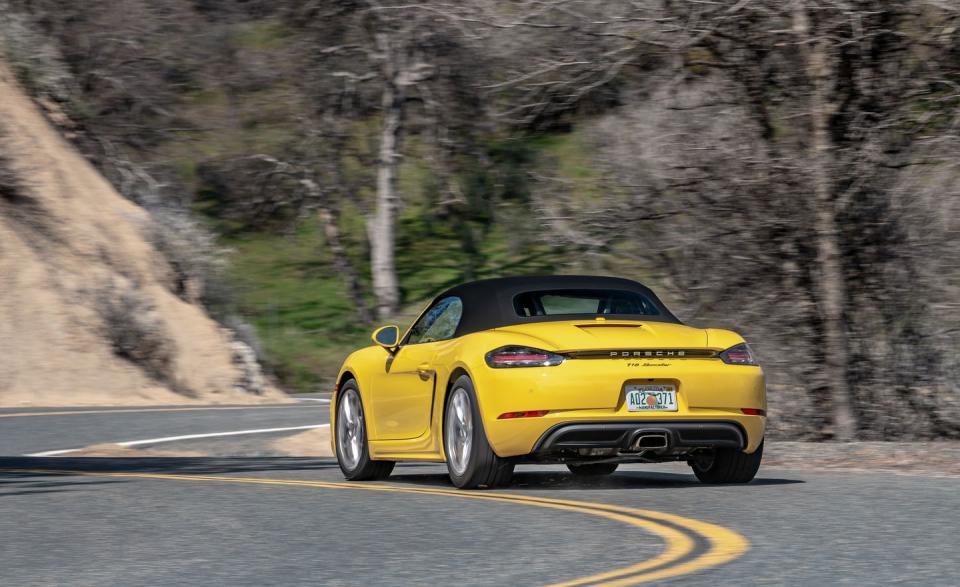
While it corners with the sharpness of a monofocused sports car, the Boxster never makes its passengers pay for the thrills. The 718's suspension compresses and rebounds with shorter strokes than the Z4's, and yet the Porsche's dialed-in dampers provide better impact absorption than the BMW's do.
The simplicity of the 718's cabin belies its price yet telegraphs its intent. The standard sport seats compensate for their limited adjustability by cradling passengers in all the right places when the road dances. The buckets set you low to the road, are snug to your torso and thighs, and spoon your spine from hips to head. From the clutter-free steering wheel, you simply drop your right hand on top of the tall, perfectly placed shifter. We also like that this particular Boxster doesn't muddle things with a glut of driving modes, either preset or customizable. Instead, a trio of buttons independently activates the sport exhaust (always), stiffer damping (sometimes), and a sharper throttle response (we'll leave that one up to you).
The Boxster is more than the sum of its test results and its relatively short equipment list. You'll know it by steering that's as natural as leaning a bike into a corner. You'll know it from a brake pedal with more feeling than an Aretha anthem. And you'll know it by the firm handshake of the shifter. The Boxster is a rare car in which every control and every dynamic attribute feels as if a single engineer tuned the whole lot. It's this simple yet fully realized vision that makes the Porsche such a rich experience.
From the June 2019 issue
('You Might Also Like',)

 Yahoo Autos
Yahoo Autos 